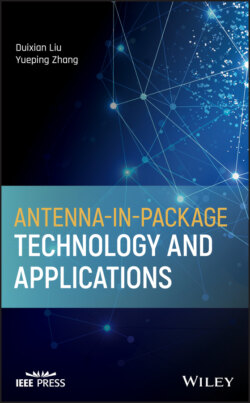Читать книгу Antenna-in-Package Technology and Applications - Duixian Liu - Страница 16
1.2 The Idea
ОглавлениеThe idea of AiP was triggered by the demand for innovative antenna solutions to wireless SoCs [6]. It features using packaging technology to implement an antenna (or antennas) with a radio or radar die (or dies) in a chip package. It emphasizes only the addition of the unique function of radiation to the package. In this sense, it is different from the concept of system‐in‐package (SiP).
The idea of AoC sounds attractive [7]. It attempts to integrate an antenna (or antennas) with other circuits on a die directly using semiconductor technology. It is obviously a subset of the concept of SoC. Then why do we specifically differentiate it from SoC? The reason is to highlight the unique property of radiation, which is not necessarily being improved like digital circuits as the technology scales down. It is clear that AoC is more suitable for terahertz applications for cost and performance reasons.
The idea of AiM was proposed for multichip 60‐GHz radios [8]. It uses micro‐assembly technology to mount a few monolithic microwave integrated circuits (MMICs) and a small flat antenna in a hermetically sealed package. A window for the propagation of electromagnetic waves is formed above the antenna at the lid of the package. The window is also hermetically sealed.
The idea of AoB is similar to the idea of AiP. However, it relies on printed circuit board (PCB) technology to make an antenna (or antennas) on one surface of a board and to solder a packaged chip (or chips) on the other surface of the board. A few techniques, such as probe feeding or aperture coupling, are available to interconnect the packaged chip with the antenna. Of course, the antenna, the packaged chip, and the necessary feed networks can be contained on the same surface of the board. Recently, the idea of AoB has received considerable attention for millimeter‐wave (mmWave) fifth‐generation (5G) base stations [9].
A typical AIA consists of active devices such as Gunn diodes or transistors that form an active circuit and a planar antenna. The idea of AIA was proposed to eliminate the lossy and bulky interconnect between the active device and radiating element [10]. Later, the idea of AIA was employed for quasi‐optical power combining. The output power from an array of many solid‐state devices was combined in free space to overcome the power limitations of individual solid‐state devices at mmWave frequencies.
Although the origin of the above ideas can be traced back to the invention of microstrip antennas in the early 1970s [11], it should be noted that they extended the concept of microstrip antennas to different levels of integration.
